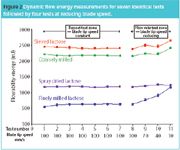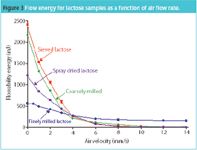Understanding powder behaviour by measurig bulk, flow and shear properties
Pharmaceutical Technology Europe
The trend towards developing pharmaceutical products and their manufacturing processes in tandem supports optimized production. Such developments rely on gathering process-relevant information at an early stage and being able to draw on past and current processing experience. Here, we discuss how powder rheometers can make a real difference in building a database of powder properties and removing subjectivity.
The pharmaceutical industry faces increasingly intense economic pressure. Not only are new chemical entity (NCE) submissions to regulatory bodies at a 20-year low, but the demands for yet more stringent regulation — alongside the continuing squeeze on revenues as patents expire and generic formulations appear on the market — present significant challenges.
Manufacturers are responding in a number of ways with two clear objectives emerging: the need to reduce production costs and the time it takes to get the product to market. In the past, pharmaceutical manufacturers have to some extent escaped the strong pressure on variable costs faced by other industries, such as bulk chemical producers. As a result there has not been the need to focus on process efficiency to the same degree.
Patent protection coupled with the rigours of process validation, which has made the introduction of new technologies during scale-up unattractive, has resulted in processes that generate the required material, but not necessarily in the most cost-effective way. The need to change this situation is now being recognized. One clear sign is FDA's process analytical technology (PAT) initiative, which is designed to encourage pharmaceutical manufacturers to embrace new analytical technologies to monitor and control their processes more closely. It is hoped that this approach will reduce risk and enhance process efficiency.
Development and optimization of a product and its manufacturing process are iterative rather than linear procedures. An approach in which the product and process are developed in tandem will lead to optimized production much more rapidly.
However, this type of development relies on gathering process-relevant information at a relatively early stage. There is, therefore, a need for analytical systems that can deliver this data in a cost-effective manner using only small amounts of material. In this article we discuss the use of powder rheometers in this context.
What's special about powders?
Powder behaviour is complex and not fully rationalized in terms of basic particle properties. It is tempting to think of powder systems as being single phase, but two-phase is a more accurate description because air content is such a significant variable. A stable tablet after all is simply a free-flowing powder mixture that has been pressed to exclude air and encourage cohesion.
Powder properties are related to physical properties such as particle size and shape, but other factors are also significant. Aeration or consolidation, the uptake of moisture, segregation and attrition, can all occur during processing, transforming the way that the powder behaves.
The powder processor's expertise lies in manipulating variables to achieve the required result, but this can be a trial and error process in the absence of analytical data that can accurately reflect processing performance.
Traditionally, process development has relied heavily on the experience of key personnel. In addition, processes have been run under manual control with operators developing a 'feel' for the material and plant — pragmatic solutions based on pulling certain levers to solve certain problems.
To move away from this approach to one more firmly rooted in technical understanding, intuition and experience must be translated into measurable variables that can be correlated with process performance. If this can be achieved, then the efficiency of both process development and operation can be improved substantially.
Pharmaceutical processing
In almost all pharmaceutical products either the active pharmaceutical ingredient (API) or excipients will be handled in solid form at some point, and, therefore, effective powder processing lies at the heart of optimized pharmaceutical production.
In terms of unit operations, core activities include reaction, homogenization/micronization, blending, drying, granulation, pressing and coating. Batch production is the norm, primarily because of the need for stringent quality control (QC).
So the question becomes: "When designing new processes or deciding whether a new product will process well in existing equipment, what powder property information will be valuable?"
With blending, the aim is to efficiently produce a fully homogeneous mix. Demands on blending processes are increasing as the trend towards lower doses of more active APIs continues. A commonly encountered problem is that blending equipment that works well for a certain set of powders may not perform adequately for others.
In this case assessing the way that materials flow and the sensitivity of flow behaviour to different variables can help developers to match material characteristics with processing equipment capability.
If the characteristics of powders that blend well can be quantified then materials with very similar flow properties can be developed, and confidence that they will process relatively easily will be high.
Drying is also a common unit operation, but it is often relatively poorly controlled. Knowing the sensitivity of a material to moisture will allow assessment of the likely impact of varying water content on downstream processes, such as tabletting; here excessive moisture can exacerbate the problem of picking, whereby material adheres to the machine resulting in an imperfect tablet.1 The effect of water content on sample rheology is also relevant in the development of successful wet granulation processes. Granulation is often used to improve the flow properties of a material, for handling and/or downstream processing reasons. If the properties of a granulate can be correlated with water content and blend time on the one hand, and subsequent processability on the other, then optimization of the granulation process, successful end-point detection and scale-up become much more straight forward.
The properties of all powders are extremely sensitive to air content and materials differ significantly in terms of the way in which they both entrain and release air. Quantification of the impact of air on the properties of a given sample is, therefore, valuable for powder processors, particularly for specific unit operations. For example, in a tabletting mix air facilitates free flow of the material into the die, but if this air is not released quickly then it will be compressed along with the powder.
If this happens the resulting tablet may laminate or split as the trapped air is released upon removal of the compression pressure. Measuring the ability of a material to deaerate allows prediction of this important aspect of tabletting performance. Aeration effects are also responsible for other widely observed processing phenomena, such as flooding of a feeder.
It is easy to recognize that some unit operations, for example, those using fluidized beds, clearly involve aeration. The critical point that is less well-understood is that even when aeration is not a specified part of the process it can occur all too easily.
Powders mix with air as they are discharged from hoppers or during pneumatic conveying and tend to deaerate whenever they are stationary. The dependence of powder properties on air content is, therefore, an aspect of powder behaviour that must be considered carefully by all powder processors.
These simple examples underscore the link between the properties of a proposed formulation and aspects of process design and operation. It is clear that data collected at an early stage, which provide understanding of the basic properties of the material, can help formulators steer away from a poor product, and guide process engineers to focus on their design efforts.
Measuring powder properties
Angle of repose, flow through a funnel or aperture and bulk density measurement methods, such as Carr and Hausner, are all established techniques for assessing the properties of powders.
Each provides some insight into a certain aspect of powder behaviour. The percentage compressibility function developed by Carr, for example, which is based upon measurement of the change in volume induced by repeated tapping, differentiates well between cohesive and free-flowing powders.
Shear testing, as initially developed in the 1960s by Jenike, is also used widely for the characterization of various aspects of, primarily, cohesive powders, such as cohesion and compression strength. There is a well-developed design methodology based on these parameters for hoppers and bins, and the information gained using this technique continues to expand with the development of modern instruments that allow determination of the shear strength of unconsolidated powders as well as preconsolidated powders.
Powder rheometers are a much more recent development designed to quantify how powders flow in ways that more closely relate to their behaviour in real processes. They describe the dynamic flow properties of powders in terms of the energy needed to cause flow.
Powders are tested dynamically by measuring the force and torque required to rotate a blade through the sample in a specific manner. Rotating the blade downwards through the sample produces a bulldozing action along the blade length, whereas upward movement induces shear with minimum consolidation.
These regimes deliver different, complementary sets of rheological data. In the absence of a unit of dynamic flowability the behaviour observed is described in terms of the energy needed to maintain the prescribed flow pattern, which is calculated from the force and torque measurements.
A key feature of powder rheometers is that a sample can be conditioned prior to measurement and gently moved to ensure that the sample bed is laid down for testing in a repeatable way. This conditioning step eliminates a significant source of variability associated with other measurement techniques and ensures high repeatability.
Differences in measurements made using a powder rheometer are a function of real powder properties not powder history. Furthermore, the dynamic measurement methodology involved is highly differentiating. These two properties combine to make powder rheometers particularly sensitive to small differences in flow properties.
Universal powder testers that can measure the bulk, shear and dynamic flow properties of powders for a full range of packing conditions have evolved from the first powder rheometers. The original concept of measuring the energy needed to cause powder flow has been extended to include automated assessments for all flow regimes — consolidated, conditioned (unstressed) and aerated or fluidized powders as well as bulk density, compressibility and permeability measurement, and shear cell modules to determine shear strength properties.
Investigating lactose properties
To illustrate the relevance of powder property testing, samples of four different types of lactose, a commonly used excipient, were investigated using a universal powder tester (as described before) to determine bulk and flow properties using both the dynamic and shear methodologies.
The bulk powder properties of compressibility and permeability were measured and the adhesive properties of the materials were assessed, by measuring the amount of material adhering to the blade following dynamic tests. Four types of lactose were used: spray-dried, sieved, coarsely and finely milled. Particle size and shape data for the samples are shown in Table 1.
The much higher compressibility of the finely milled lactose is a clear indication of its higher cohesivity and this is reinforced by the adhesion data, which show that this powder is, by a significant margin, the most adhesive of the materials tested. Both characteristics are important and in the case of finely milled lactose, the high values indicate that difficulties should be expected during processing
Figure 1 shows yield locus data, measured in the shear tests, for each of the samples. The finely milled lactose exhibits higher shear strength than the other materials, which have larger particles and tend to flow more freely. The spray-dried lactose has the lowest value of all, probably as a result of its spherical shaped particles.

Figure 1 Yield strength loci for varying normal stress levels for powders previously preconsolidated to 9 kPa stress.
For the finely milled lactose it was possible to extrapolate the yield loci and use a Mohr's circle analysis to derive the unconfined yield strength, maximum principal stress and flowability. This analysis was not possible with any accuracy for the less cohesive materials as their extrapolated yield loci were close to passing through zero.
Flow energy measurements for the different lactose samples determined using dynamic tests are presented in Figure 2.

Figure 2 Dynamic flow energy measurements for seven identical tests followed by four tests at reducing blade speed.
Repeatability is good, highlighting the stable rheology of the samples. A wide range of flow energies is measured reflecting the rheological differences between the types of lactose; marked differentiation between materials is evident.
Any method of comparing flow properties would show differences between the cohesive, finely milled lactose and the other three coarse grained powders. However, this specific ability to differentiate between very similar powders is most important to the powder processor, especially when faced with issues of batch-to-batch variability.
Interestingly, the finely milled lactose is associated with the lowest flow energy even though it has the highest shear strength. The compressibility, permeability and adhesion data for the samples shown in Table 1 helps interpretation of the flow energy measurements. Cohesive powders such as the finely milled lactose tend to contain relatively large amounts of air and are far more easily compressed. As a result the flow zone of material — the numbers of particles moving at any instant as the blade rotates and, therefore, the energy required to maintain flow — tends to be relatively small. In contrast, for noncohesive materials relatively large amounts of the sample are moved simultaneously as the blade is rotated and a higher flow energy is seen. These results highlight the dependency of flow energy measurements on a range of factors, not only shear strength, but also cohesion, compressibility and physical properties.

Table 1 Properties of lactose samples.
Changes in flow energy induced by aeration are evident from Figure 3. It is clear that aeration has a much more significant impact on the flowability of the coarser lactose samples than on the finely milled material. The coarsely milled and sieved lactose in particular show a rapid rate of flow energy reduction even at relatively low air flow rates because of separation of their large, angular particles.

Figure 3 Flow energy for lactose samples as a function of air flow rate.
The spray-dried lactose initially aerates slightly more slowly — a behaviour attributed to its high permeability (Figure 4).

Figure 4 Pressure drop through powder bed at constant 2 mm/s air velocity as a function of applied normal stress.
Flow energy of the finely milled lactose sample is relatively insensitive to air flow rate because the powder is cohesive and not permeable. The other three powders are affected by small amounts of air and eventually, given sufficient air, will fluidize. These characteristics are of great importance to the process engineer because they will determine, to a major extent, the consistency of flow through a process. Cohesive powders that will not aerate and free-flowing powders that can fluidize are both likely to present serious challenges.
Conclusion
Recent advances in powder rheometers have led to their development as integrated powder testers, which enable researchers to investigate materials in ways that are highly relevant to different aspects of process design and operation. Particularly important is the ability to study systematically the impact of aeration. Dynamic testing is highly differentiating and offers a precise tool for uncovering subtle, but potentially important, differences between materials. When this is coupled with the ability to measure bulk properties and shear strength, the powder rheometer allows a comprehensive study of the factors that influence a powder's behaviour and processability.

Key points
Within the pharmaceutical industry a wide range of powders is processed to make products that transform our lives. The processes that are used have been developed, and in many cases are still operated by, experienced personnel who have, through practical experimentation, constructed successful troubleshooting methods for dealing with the problems they encounter daily. However, to rise to the current challenges, the industry must use new tools to understand its processes in much greater detail, to accelerate the development process and sharpen control strategies.
By enabling the establishment of databases of powder properties, the powder rheometer ensures that no experience is wasted. Knowledge of how a particular powder behaves, or a specific plant operates, can be linked to the measured data. The end result is a better understanding of existing daily issues, the ability to optimize the selection or design of process plants and a much reduced risk for the introduction of new products.
Reg Freeman is managing director and James Cooke is materials scientist, both at Freeman Technology Ltd (UK).
References
1. F. Rowley, Pharmaceutical Technology Europe 17(10), 42–48 (2005).
2. D.S. Dick, The Chemical Engineer 40–41, February 2006.
3. R.E. Freeman, Measuring the flow properties of consolidated, conditioned and aerated powders — a comparative study using a powder rheometer and a rotational shear cell, Particle Systems Analysis Conference, Stratford, UK, 2005.

Drug Solutions Podcast: A Closer Look at mRNA in Oncology and Vaccines
April 30th 2024In this episode fo the Drug Solutions Podcast, etherna’s vice-president of Technology and Innovation, Stefaan De Koker, discusses the merits and challenges of using mRNA as the foundation for therapeutics in oncology as well as for vaccines.